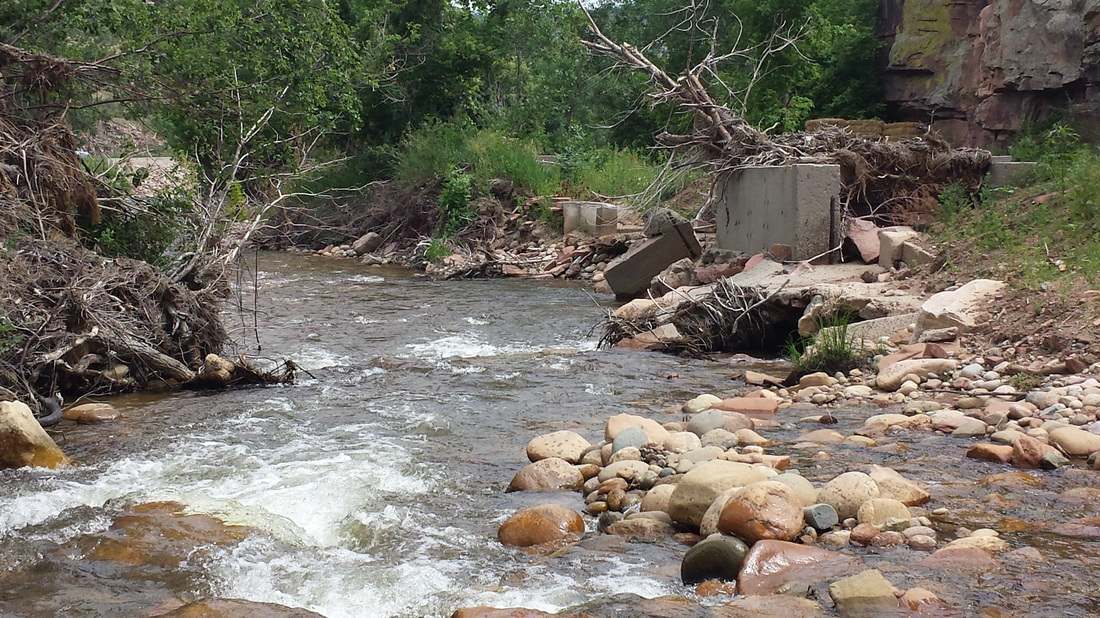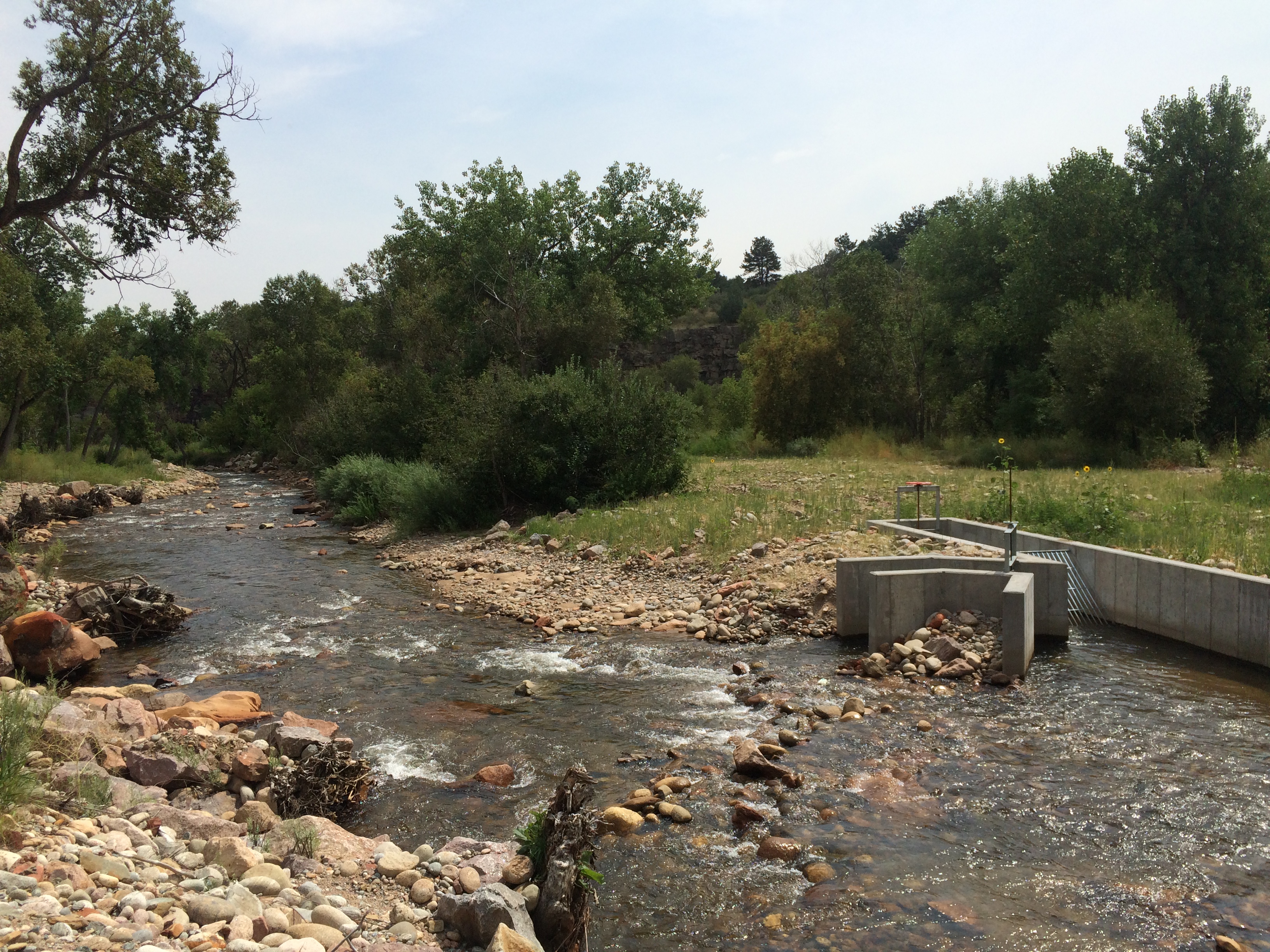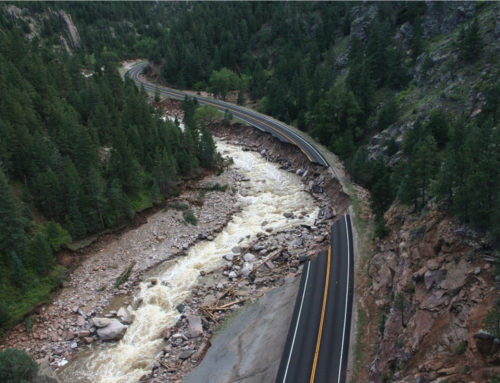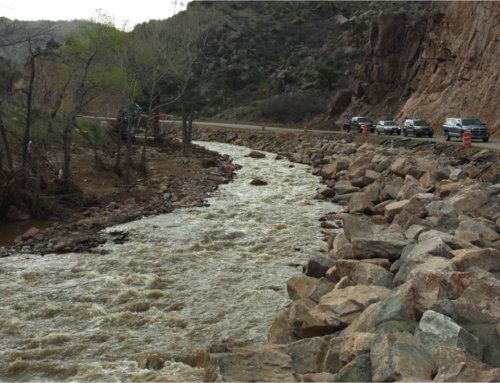Project Description
MEADOW & SOUTH LEDGE
IRRIGATION DIVERSION AND
FISH PASSAGE DEMONSTRATION
MULTI-OBJECTIVE
Fisheries Enhancement
Agriculture
Life Safety
Recreation
Flood hazard Reduction
Community Engagement
Fish Passage Demonstration
Innovative irrigation diversions like the one recently reconstructed on South Saint Vrain Creek near Lyons are leading the way for other Colorado ditchcompaniestomake their structures better for agriculture and the environment, and safer for people.
After the September 2013 flood destroyed many diversion structures along creeks in Boulder County, ditch owners had to rebuild. Normally the solution would be to reconstruct a concrete cross-channel dam, or put rocks in the bottom of the river to raise it to the level of the ditch. However, these options can create a barrier to natural fish migration, and a potential life safety hazard for boaters, anglers or tubers.
Fish require water and connected habitats to support healthy populations. Rivers fragmented by dams or small, poorly placed road culverts prevent fish from accessing habitat. Improperly designed dams can also create dangerous hydraulics that can trap boaters and anyone unlucky enough to go over them at certain flows.
Looking to rebuild in a sustainable manner while still receiving a full allotment of irrigation water, the Meadow and South Ledge ditch companies coordinated with a range of community stakeholders. State, Federal and local funding contributed toward the costs of engineering design, permitting, construction, outreach and monitoring.
Innovative engineering design developed by Crane Associates from Carbondale, Colorado worked to eliminate the need for a cross-channel dam. Nicknamed “chasing grade” it uses the natural changes in grade of this foothills creek to pressurize and feed the ditch system using gravity alone, without the need for a barrier dam. Designed as a demonstration, the project aims to show how fish passage can be economically and effectively integrated into river diversion structures, while delivering a full decree of water to community water users.
Project Description
This demonstration project rebuilt two irrigation diversions for the Meadow and South Ledge ditch companies after those structures were destroyed in the 2013 flood. The structures were re-engineered to allow agricultural irrigation, as well as fish and recreational passage in this portion of South Saint Vrain Creek.
First, the points of diversion for the two old structures were combined and moved some 800 feet upstream, increasing the amount of fall (change in elevation) by at least three feet. Then an off-channel water intake structure was constructed below the existing grade of the streambed. This structure feeds an underground pipeline via gravity that runs downhill to a splitter box, which services both ditches.
The ability to move the diversion upstream may be the most important component of this project. By “chasing grade” upstream and using gravity to supply water through a pipeline, the ditch companies were able to divert their water without an instream structure that impedes fish migration, and acts as a potential life safety hazard for recreation.
In 2014, the Colorado General Assembly allowed that when a stream channel changes due to natural events such as flooding, rendering a headgate inoperable, the ditch owner may move the headgate upstream without filing a change of water right application – as long as the relocation does not interfere with the use or enjoyment of any decreed or absolute conditional water right.
In non-flood scenarios, the point of diversion may also be changed using form JDF 241W – Application for Simple Change in Surface Point of Diversion, which can be obtained on the Colorado Judicial Branch website under “forms.” This process need not involve going to water court, or hiring an attorney, as long as the conditions of non-injury can be met.
Reconstructing flood-damaged infrastructure to accommodate environmental and recreation needs is considered critical in this stretch of South Saint Vrain Creek, an area highlighted in the Colorado Water Plan (2015) as a “Recreational Focus Area.1” South St. Vrain Creek also connects with downstream segments of the main stem of Saint Vrain Creek identified as “Environmental and Recreational Focus Areas” containing State-identified fish species of concern.
This project further supports the St. Vrain Creek Watershed Master Plan (2014) objectives for this reach, promoting natural channel design, sediment transport, agricultural water use, recreation, and fish passage.
1 South Platte Basin Implementation Plan (2014), a part of Colorado’s Water Plan (2015)
BEFORE
The flood in September 2013 obliterated the channels that previously fed the Meadow and South Ledge ditches off South St. Vrain Creek. The historic flood completely destroyed the existing Meadow and South Ledge irrigation diversion structures, clogging them with tree roots and debris, and scouring down the riverbed around the diversions, leaving the location of the old structures high and dry.
Both the South Ledge and the Meadow ditches are small-scale operations with limited resources irrigating family farms, businesses and the local school grounds. With water rights dating back to the 1860s, the companies committed to suspending 2014 irrigation operations in order to rebuild in the most resilient and sustainable manner possible.
AFTER
An off-channel intake structure was constructed, which feeds an underground pipeline that runs downhill via gravity to a splitter box, servicing both ditches.
The original Meadow Ditch diversion was just 600 feet downstream of the South Ledge diversion so consolidating the two diversions into one made both ecological and economic sense. Consolidation of two diversions generated substantial savings in construction and maintenance costs. The Meadow and South Ledge ditch companies were able to pool their limited resources and successfully apply for grants by working together while maintaining their individual water rights and ditch infrastructure. The joint diversion structure, piping, and splitter box are managed by the water commissioner and therefore reduce potential for conflict.
Project Team
Project sponsors came together to fund and build this project for the mutual benefit of the family farms, businesses, and local school that use this water, as well as the fishing and recreational community in Lyons, and the aquatic environment. State, Federal and local funding contributed toward the costs of data collection, engineering design, permitting, construction, outreach, and monitoring.
This project would not have been possible without the support and cooperation of the representatives from the Meadow and South Ledge ditch companies. In addition to the hours spent in coordination, grant development, and financial review, both companies agreed to defer irrigation for the 2014 season in order to develop an improved, more resilient flood recovery project.












Leave A Comment
You must be logged in to post a comment.